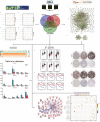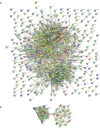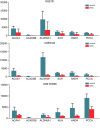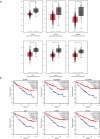The promising novel biomarkers and candidate small molecule drugs in kidney renal clear cell carcinoma: Evidence from bioinformatics analysis of high-throughput data
- PMID: 30793530
- PMCID: PMC6503072
- DOI: 10.1002/mgg3.607
The promising novel biomarkers and candidate small molecule drugs in kidney renal clear cell carcinoma: Evidence from bioinformatics analysis of high-throughput data
Abstract
Background: Kidney renal clear cell carcinoma (KIRC) is the most common subtype of renal tumor. However, the molecular mechanisms of KIRC pathogenesis remain little known. The purpose of our study was to identify potential key genes related to the occurrence and prognosis of KIRC, which could serve as novel diagnostic and prognostic biomarkers for KIRC.
Methods: Three gene expression profiles from gene expression omnibus database were integrated to identify differential expressed genes (DEGs) using limma package. Enrichment analysis and PPI construction for these DEGs were performed by bioinformatics tools. We used Gene Expression Profiling Interactive Analysis (GEPIA) database to further analyze the expression and prognostic values of hub genes. The GEPIA database was used to further validate the bioinformatics results. The Connectivity Map was used to identify candidate small molecules that could reverse the gene expression of KIRC.
Results: A total of 503 DEGs were obtained. The PPI network with 417 nodes and 1912 interactions was constructed. Go and KEGG pathway analysis revealed that these DEGs were most significantly enriched in excretion and valine, leucine, and isoleucine degradation, respectively. Six DEGs with high degree of connectivity (ACAA1, ACADSB, ALDH6A1, AUH, HADH, and PCCA) were selected as hub genes, which significantly associated with worse survival of patients. Finally, we identified the top 20 most significant small molecules and pipemidic acid was the most promising small molecule to reverse the KIRC gene expression.
Conclusions: This study first uncovered six key genes in KIRC which contributed to improving our understanding of the molecular mechanisms of KIRC pathogenesis. ACAA1, ACADSB, ALDH6A1, AUH, HADH, and PCCA could serve as the promising novel biomarkers for KIRC diagnosis, prognosis, and treatment.
Keywords: bioinformatics analysis; candidate small molecules; kidney renal clear cell carcinoma; novel biomarkers.
© 2019 The Authors. Molecular Genetics & Genomic Medicine published by Wiley Periodicals, Inc.
Conflict of interest statement
None.
Figures









Similar articles
-
Integrated bioinformatics analysis reveals novel key biomarkers and potential candidate small molecule drugs in gastric cancer.Pathol Res Pract. 2019 May;215(5):1038-1048. doi: 10.1016/j.prp.2019.02.012. Epub 2019 Feb 28. Pathol Res Pract. 2019. PMID: 30975489
-
Screening Novel Drug Candidates for Kidney Renal Clear Cell Carcinoma Treatment: A Study on Differentially Expressed Genes through the Connectivity Map Database.Kidney Blood Press Res. 2021;46(6):702-713. doi: 10.1159/000518437. Epub 2021 Oct 11. Kidney Blood Press Res. 2021. PMID: 34818247
-
FMR1 is identified as an immune-related novel prognostic biomarker for renal clear cell carcinoma: A bioinformatics analysis of TAZ/YAP.Math Biosci Eng. 2022 Jun 24;19(9):9295-9320. doi: 10.3934/mbe.2022432. Math Biosci Eng. 2022. PMID: 35942760
-
MicroRNA related prognosis biomarkers from high throughput sequencing data of kidney renal clear cell carcinoma.BMC Med Genomics. 2021 Mar 9;14(1):72. doi: 10.1186/s12920-021-00932-z. BMC Med Genomics. 2021. PMID: 33750388 Free PMC article.
-
The discovery of promising candidate biomarkers in kidney renal clear cell carcinoma: evidence from the in-depth analysis of high-throughput data.Am J Cancer Res. 2023 Sep 15;13(9):4288-4304. eCollection 2023. Am J Cancer Res. 2023. PMID: 37818073 Free PMC article.
Cited by
-
Decoding signal transducer and activator of transcription 1 across various cancers through data mining and integrative analysis.Am J Transl Res. 2022 Jun 15;14(6):3638-3657. eCollection 2022. Am J Transl Res. 2022. PMID: 35836889 Free PMC article.
-
The Physiological and Pathological Role of Acyl-CoA Oxidation.Int J Mol Sci. 2023 Oct 3;24(19):14857. doi: 10.3390/ijms241914857. Int J Mol Sci. 2023. PMID: 37834305 Free PMC article. Review.
-
ABAT and ALDH6A1, regulated by transcription factor HNF4A, suppress tumorigenic capability in clear cell renal cell carcinoma.J Transl Med. 2020 Feb 24;18(1):101. doi: 10.1186/s12967-020-02268-1. J Transl Med. 2020. PMID: 32093682 Free PMC article.
-
HADH suppresses clear cell renal cell carcinoma progression through reduced NRF2-dependent glutathione synthesis.Transl Oncol. 2024 Nov;49:102112. doi: 10.1016/j.tranon.2024.102112. Epub 2024 Sep 2. Transl Oncol. 2024. PMID: 39226735 Free PMC article.
-
A Prognostic Signature for Clear Cell Renal Cell Carcinoma Based on Ferroptosis-Related lncRNAs and Immune Checkpoints.Front Genet. 2022 May 24;13:912190. doi: 10.3389/fgene.2022.912190. eCollection 2022. Front Genet. 2022. PMID: 35685438 Free PMC article.
References
-
- Bandettini, W. P. , Kellman, P. , Mancini, C. , Booker, O. J. , Vasu, S. , Leung, S. W. , … Arai, A. E. (2012). MultiContrast Delayed Enhancement (MCODE) improves detection of subendocardial myocardial infarction by late gadolinium enhancement cardiovascular magnetic resonance: A clinical validation study. Journal of Cardiovascular Magnetic Resonance, 14, 83 10.1186/1532-429x-14-83 - DOI - PMC - PubMed
-
- Bray, F. , Ferlay, J. , Soerjomataram, I. , Siegel, R. L. , Torre, L. A. , & Jemal, A. (2018). Global cancer statistics 2018: GLOBOCAN estimates of incidence and mortality worldwide for 36 cancers in 185 countries. CA: A Cancer Journal for Clinicians, 68(6), 394–424. 10.3322/caac.21492 - DOI - PubMed
-
- Cerami, E. , Gao, J. , Dogrusoz, U. , Gross, B. E. , Sumer, S. O. , Aksoy, B. A. , … Schultz, N. (2012). The cBio cancer genomics portal: An open platform for exploring multidimensional cancer genomics data. Cancer Discovery, 2(5), 401–404. 10.1158/2159-8290.cd-12-0095 - DOI - PMC - PubMed
Publication types
MeSH terms
Substances
Grants and funding
LinkOut - more resources
Full Text Sources
Medical
Miscellaneous

